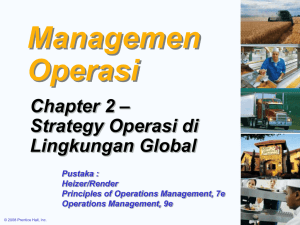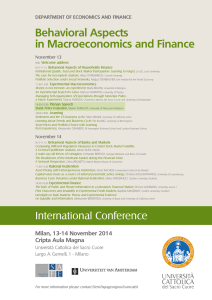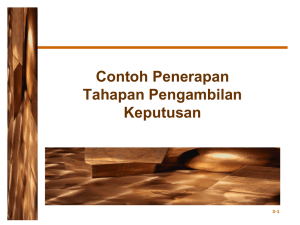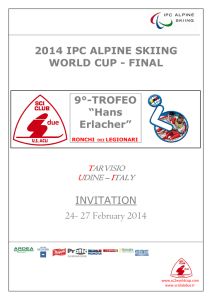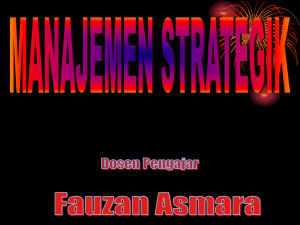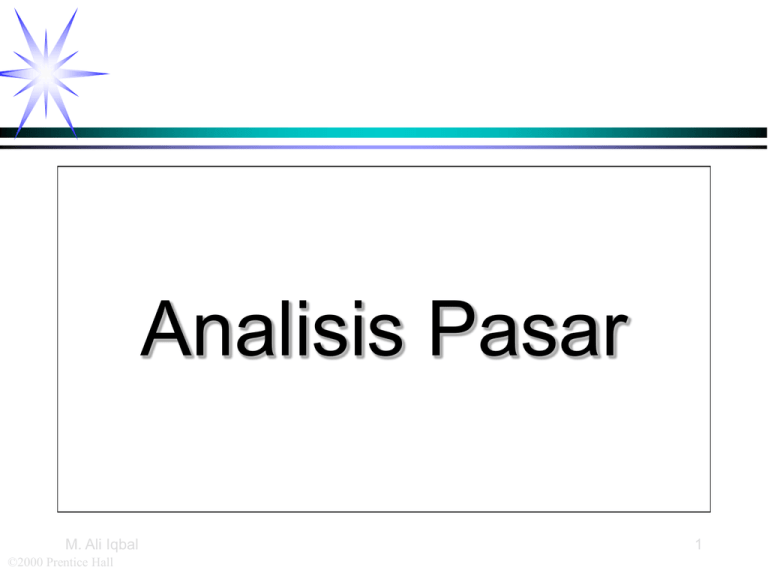
Analisis Pasar
M. Ali Iqbal
©2000 Prentice Hall
1
MARKETS AND COMPETITIVE
SPACE
Markets and Strategies
Product-Market Scope and
Structure
Describing and Analyzing EndUsers
Analyzing Competition
Developing a Strategic Vision
M. Ali Iqbal
about the Future
©2000 Prentice Hall
2
MARKETS AND COMPETITIVE
SPACE
The Challenges ―
Markets are increasingly complex, turbulent, and
interrelated.
Importance of a broad view of the market.
Essential to develop a vision about how the
market is likely to change in the future.
M. Ali Iqbal
©2000 Prentice Hall
3
MARKETS AND COMPETITIVE
SPACE
Continuous Monitoring is Necessary to:
Find promising opportunities
Identify shifts in value requirements
Understand competitors’ positioning
Guide targeting and positioning
decisions
M. Ali Iqbal
©2000 Prentice Hall
4
Faktor-faktor yang Mempengaruhi
Kompleksitas Pasar
Perubahan
komposisi pasar
Fungsi
pelanggan
Pertimbangan aspek fungsi produk
yang bermanfaat bagi konsumen
Sepatu olah raga tidak hanya
berfungsi untuk olah raga tapi juga
mempunyai fungsi lainnya.
PC sebagai entertaiment, internet
dan bisnis
M. Ali Iqbal
©2000 Prentice Hall
5
Faktor-faktor yang Mempengaruhi
Kompleksitas Pasar
Teknologi
Fungsi
konsumen dapat di puaskan
dgn produk yang menggunakan
teknologi yang berbeda
Gas dan listrik menggunakan
berbagai sumber energi untuk
pemanas, pendingin dan fungsi
lainya
M. Ali Iqbal
©2000 Prentice Hall
6
Faktor-faktor yang Mempengaruhi
Kompleksitas Pasar
Segmen
pelanggan
Kebutuhan konsumen yg beraneka
ragam untuk produk tertentu.
Orang Eropa lebih suka dengan
luxury Sedan dan mobil sport.
Orang Indonesia lebih suka
dengan kendaraan minibus
M. Ali Iqbal
©2000 Prentice Hall
7
MARKETS AND
STRATEGIES
Markets and
Strategies are
Interlinked
Forming
Value Migration
a Shared
Vision
Challenges
M. Ali Iqbal
©2000 Prentice Hall
8
Markets Impact Strategies
Market
changes often require altering
strategies
Forces of change create both market
opportunities and threats
M. Ali Iqbal
©2000 Prentice Hall
9
Value Migrations
Customers
shift purchasing to new
business designs with enhanced
value offering
Be aware of disruptive technologies
Market sensing and organizational
learning are essential
M. Ali Iqbal
©2000 Prentice Hall
10
Figure
Changing
Consumer
Needs
M. Ali Iqbal
©2000 Prentice Hall
11
Figure
Progress
is a
Winning
Appeal
M. Ali Iqbal
©2000 Prentice Hall
12
PRODUCT-MARKET SCOPE AND
STRUCTURE
Matching Needs with Product Benefits
Product-Market Boundaries and Structure
Forming Product-Markets for Analysis
The Changing Composition of Markets
M. Ali Iqbal
©2000 Prentice Hall
13
Matching Needs with Product
Benefits
A product – market matches people with
needs to the product benefits that
satisfy those needs
“A product – market is the set of products
judged to be substitutes within those
usage situations in which similar
patterns of benefits are sought by
groups of customers.”*
M.
Ali Iqbal et al. (1984) Journal of Marketing, Spring, 32.
*Srivastava,
©2000 Prentice Hall
14
Product – Market Boundaries and
Structure
Determining Product-Market Structure
1. Start with the generic need satisfied by
the product category of interest to
management
2. Identify the product categories (types)
that can satisfy the generic need
3. Form the specific product – markets
within the generic product – market
M. Ali Iqbal
©2000 Prentice Hall
15
Illustrative Fast-Food
Product-Market Structure
SUPER
MARKETS
MICROWAVE
OVENS
FAST-FOOD
MARKET
CONVENIENCE
STORES
M. Ali Iqbal
©2000 Prentice Hall
TRADITIONAL
RESTAURANTS
16
Forming Product – Markets for
Analysis
Factors influencing product –
market boundaries:
Purpose of analysis
Changing composition of
markets
Extent of market
complexity
M. Ali Iqbal
©2000 Prentice Hall
17
Faktor-faktor yang Mempengaruhi Sifat
dan Lingkup batas Produk
Tujuan Analisis
Jika tujuan menarik segmen pasar perlu
dilakukan penetrasi pasar
Jika perbedaan produk memuaskan kebutuhan
yg sama, batasan produknya harus berisi
seluruh produk yg relevan
Contoh : pasar produk photography harus
memasukkan juga kamera digital, servis, dan
film.
M. Ali Iqbal
©2000 Prentice Hall
18
Faktor-faktor yang Mempengaruhi
Kompleksitas Pasar
Perubahan komposisi pasar
Fungsi pelanggan
Pertimbangan
aspek fungsi produk yang
bermanfaat bagi konsumen
Sepatu olah raga tidak hanya berfungsi
untuk olah raga tapi juga mempunyai fungsi
lainnya.
PC sebagai entertaiment, internet dan bisnis
M. Ali Iqbal
©2000 Prentice Hall
19
Faktor-faktor yang Mempengaruhi
Kompleksitas Pasar
Teknologi
Fungsi konsumen dapat di puaskan
dgn produk yang menggunakan
teknologi yang berbeda
Gas dan listrik menggunakan
berbagai sumber energi untuk
pemanas, pendingin dan fungsi lainya
M. Ali Iqbal
©2000 Prentice Hall
20
Faktor-faktor yang Mempengaruhi
Kompleksitas Pasar
Segmen pelanggan
Kebutuhan konsumen yg beraneka ragam
untuk produk tertentu.
Orang Eropa lebih suka dengan luxury
Sedan dan mobil sport.
Orang Indonesia lebih suka dengan
kendaraan minibus
M. Ali Iqbal
©2000 Prentice Hall
21
Extent of Market Complexity
Three characteristics of markets:
1. Functions or uses of the
product
2. The enabling technology of
the product
3. Customer segments in the
product-market
M. Ali Iqbal
©2000 Prentice Hall
22
Illustrative Product – Market
Structure
Food and beverages
for breakfast meal
•Generic Product
Class
•Product Type
Cereals
•Variant A
Ready to eat
Regular
Natural
Nutritional
Life
M. Ali Iqbal
©2000 Prentice Hall
Product 19
Pre-sweetened
Special K
•Variant B
•Brands
23
DEFINING AND ANALYZING
MARKETS
Define Product-Market Boundaries and
Structures
Identify and Describe End-Users
Analyze Industry and Value Added
Chain
Evaluate Key Competitors
M. Ali Iqbal
©2000 Prentice Hall
Forecast Market Size
and Growth Trends
24
Identifying and
Describing Buyers
Building
Customer
Profiles
DESCRIBING
AND
ANALYZING
END-USERS
How
Buyers
Make
Choices
Environmental
Influences
M. Ali Iqbal
©2000 Prentice Hall
25
Identifying and Describing EndUsers
Illustrative buyer characteristics in
consumer markets:
Family size, age, income, geographical
location, sex, and occupation
Illustrative factors in organizational
markets:
Type of industry
Company size
Location
M.Ali Iqbal
Type of products
©2000 Prentice Hall
26
How Buyers Make Choices
BUYING DECISION PROCESS:
1.
2.
3.
4.
5.
Problem recognition
Information search
Alternative evaluation
Purchase decision
Post-purchase behavior
M. Ali Iqbal
©2000 Prentice Hall
27
Environmental
Influences
External factors influencing
buyers’ needs and wants:
Government, social change,
economic shifts, technology etc.
These factors are often noncontrollable but can have a
major impact on purchasing
decisionns.
M. Ali Iqbal
©2000 Prentice Hall
28
Building Customer Profiles
Start with generic product – market
Move next to product- type and
variant profiles >> increasingly
more specific
Customer profiles guide decision
making (e.g. targeting, positioning,
market segmentation etc.)
M. Ali Iqbal
©2000 Prentice Hall
29
ANALYZING COMPETITION
1. Define Industry
Structure and
Characteristics
5. Identify
New
Competitors
4. Anticipate
Actions by
Competitors
M. Ali Iqbal
©2000 Prentice Hall
PRODUCTMARKET
STRUCTURE
AND
MARKET
SEGMENTS
2. Identify and
Describe Key
Competitors
3. Evaluate
Key
Competitors
30
Examples of Levels of
Competition
Baseball
cards
Bottle
water
Fast
Food
Regular
colas
Beer
Fruit
flavored
colas
Juices
M. Ali Iqbal
©2000 Prentice Hall
Diet
Coke
Video
Games
Diet lemon
limes
Diet-Rite
Cola
Ice
Cream
Diet Pepsi
Product from
competition:
diet colas
Product category
competition:
soft drinks
Generic competition:
beverages
Budget competition:
food & entertainment
Wine
Lemon
limes
Coffee
31
Industry Analysis
Industry size, growth, and composition
Typical marketing practices
Industry changes that are anticipated
(e.g. consolidation trends)
Industry strengths and weaknesses
Strategic alliances among competitors
M. Ali Iqbal
©2000 Prentice Hall
32
Defining Industry Structure &
Characteristics
SUPPLIERS
Industry Form
Industry
Environment
Competitive
Forces
PRODUCERS
WHOLESALERS/
DISTRIBUTORS
RETAILERS/DEAL
ERS
M. Ali Iqbal
©2000 Prentice Hall
CONSUMER/
ORGANIZATIONAL END
USERS
Value
Added
Chain
33
Jaringan Penyerahan Nilai Levi’s
Pesanan
Du Pont
(Serat)
Pesanan
Milliken
(bahan)
Pesanan
Levi’s
(Pakaian)
Pesanan
Sears
(Eceran)
Pelang
Persaingan terjadi antara jaringan, bukan perusahaan
Pemenangnya adl perusahan dgn jaringan
yg lebih baik
M. Ali Iqbal
©2000 Prentice Hall
34
Competitive Forces
1. Rivalry among existing firms.
2. Threat of new entrants.
3. Threat of substitute products.
4. Bargaining power of suppliers.
5. Bargaining power of buyers.
Source:
Michael E. Porter, Competitive Advantage, Free Press, 1985, 5.
M.
Ali Iqbal
©2000 Prentice Hall
35
Analisis Pesaing
Persaingan diantara perusahaan yang
ada
Pertumbuhan
industri yang cepat
Pertumbuhan
industri yg
cepat memberikan sejumlah
perusahaan untuk masuk ke
dalamnya.
M. Ali Iqbal
©2000 Prentice Hall
36
Analisis Pesaing
Ancaman
pendatang baru
Ancaman
pendatang baru tergantung
adanya penghalang masuk
Beberapa penghalang masuk :
Skala
ekonomi : keunggulan biaya yang
berhubungan dengan ukuran
perusahaan.
Diferensiasi (unik).
Kebutuhan modal : investasi yang besar
M. Ali Iqbal
©2000 Prentice Hall
37
Analisis Pesaing
Ancaman produk pengganti
Segmen tidak menarik jika terdapat
produk substitusi
Substitusi membatasi harga dan laba
yang dapat dihasilkan oleh suatu
segmen
M. Ali Iqbal
©2000 Prentice Hall
38
Analisis Pesaing
Kekuatan penawaran pemasok
Pemasok cenderung lebih kuat jika
mereka terkonsentrasi dan
terorganisasi
Pemasok perusahaan menaikkan
harga
Mengurangi kuantitas yang dipasok
M. Ali Iqbal
©2000 Prentice Hall
39
Analisis Pesaing
Kekuatan
penawaran pembeli
Pembeli
cenderung lebih kuat jika
mereka terkonsentrasi dan
terorganisasi
Pembeli
akan memaksa agar harga
diturunkan
Meminta lebih banyak mutu dan pelayanan
Membuat para pesaing saling beradu
M. Ali Iqbal
©2000 Prentice Hall
40
Key Competitor Analysis
Business scope and objectives
Management experience, capabilities,
and weaknesses
Market position and trends
Market target(s) and customer base
Marketing program positioning strategy
Financial, technical, and operating
capabilities
Key competitive advantages (e.g., access
M. Alito
Iqbalresources, patents)
41
©2000 Prentice Hall
Extent of
Market Coverage
Current
Capabilities
Competitor
Evaluation
Customer
Satisfaction
Past
Performance
M. Ali Iqbal
©2000 Prentice Hall
42
MARKET SIZE ESTIMATION
Product-Market Forecast
Relationships
(area denotes sales in $’s)
Market Potential
Estimate
Unrealized
Potential
M. Ali Iqbal
©2000 Prentice Hall
Company
Sales
Industry
Sales
43
Product-Market Forecast Relationships
for Industrial Painting Units
Sales (in 1000s
of units)
900
800
700
600
500
400
300
200
100
0
2001
2002
M. Ali Iqbal
©2000 Prentice Hall
Market
Potential
Sales Forecast
Company XYZ
Sales Forecast
2003
2004
2005
2006
2007
2008
44

